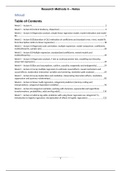Class notes
Zeer uitgebreide college aantekeningen Research Methods II (1a t/m 7a)
- Course
- Institution
- Book
In de afgelopen weken heb ik alle colleges van Research Methods 2 vrijwel letterlijk woord-voor-woord overgenomen. Het document is dus een soort samenvatting van alle colleges in jip-en-janneke taal met veel voorbeelden die door Mr. Lehr worden gegeven.
[Show more]




